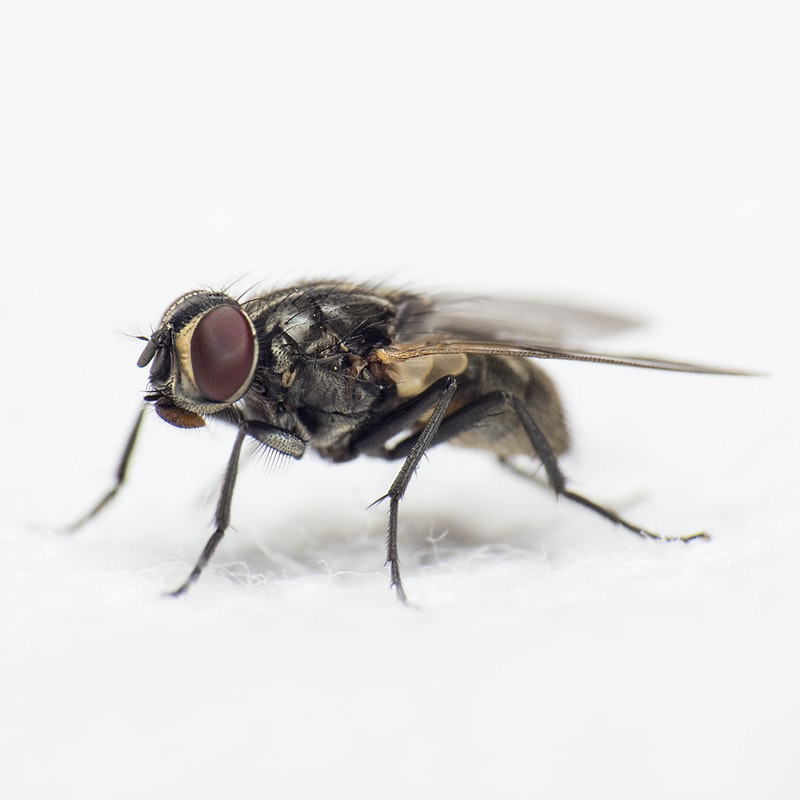Phorid flies, often found buzzing around decaying matter, are a common nuisance in homes. Unlike fruit flies that cluster near ripened produce, phorid flies can be found throughout your house, drawn to less obvious sources of organic decay. Given their presence in less-than-sanitary environments, a common question arises: Do Phorid Flies Bite Humans? It’s essential to understand the real risks associated with these pests and how to manage infestations effectively.
What are Phorid Flies? Identifying These “Humpback Flies”
Phorid flies are small insects, typically measuring about 1/16th to 1/8th of an inch in length. In terms of size, they are often mistaken for fruit flies due to their similar dimensions. Their coloration ranges from dull brown and yellowish-brown to black. One of the key identifiers of phorid flies is the distinctive hump on their thorax, which gives them the common nickname “humpback flies.” Another characteristic behavior is their tendency to run quickly across surfaces rather than immediately flying away. This scurrying movement has also earned them the moniker “scuttle flies.”
Do Phorid Flies Bite or Pose Other Dangers?
The good news is that phorid flies do not bite humans. They lack the mouthparts necessary to pierce skin and draw blood. However, dismissing them as harmless would be a mistake. The real danger of phorid flies lies in their ability to spread diseases. They frequent unsanitary locations, feeding and breeding on decaying organic matter, which allows them to pick up various bacteria and pathogens. These disease-causing agents can then be easily transferred to human environments, particularly contaminating food preparation surfaces and food itself. This transmission occurs when phorid flies land on surfaces after having been in contact with filth, effectively spreading illness without biting.
Furthermore, a phorid fly infestation can be an indicator of underlying problems within a property. Their presence often suggests hidden sources of decay, such as a dead animal within walls, or damaged and leaking plumbing pipes that create consistently damp and decaying environments.
 Close-up of a Phorid Fly: Identifying features like small size, brown color, and humped thorax to distinguish them from biting insects. Image courtesy of ASAP Pest Control.
Close-up of a Phorid Fly: Identifying features like small size, brown color, and humped thorax to distinguish them from biting insects. Image courtesy of ASAP Pest Control.
Recognizing a Phorid Fly Infestation in Your Home
Identifying a phorid fly problem involves noticing where these pests congregate. Adult phorid flies are commonly seen near basement floor drains, in bathrooms, and around indoor potted plants where soil may be overly moist or decaying. You might also spot them scuttling across various surfaces like TV screens, computer monitors, or windows. Kitchen, bathroom, and laundry room counters are also frequent runways for these flies as they search for food sources.
Effective Phorid Fly Control: Why Professional Help is Often Necessary
Getting rid of phorid flies can be challenging due to their rapid breeding cycle and their ability to lay eggs in concealed and often inaccessible locations. Homeowners often find that DIY methods and over-the-counter pesticides are ineffective in completely eliminating infestations. This is because simply killing adult flies doesn’t address the root of the problem – the breeding source. A successful phorid fly extermination requires identifying and eliminating the source of decay, which might involve repairing clogged drains, fixing leaky pipes, or removing hidden decaying organic matter. Because of the complexities involved in locating breeding sites and ensuring complete eradication, contacting professional pest control services is often the most effective solution for dealing with a phorid fly infestation.
Call Professional Pest Control for Phorid Fly Issues
If you suspect a phorid fly infestation in your home, remember that while phorid flies do not bite, they do present a health risk due to disease transmission. For effective and lasting phorid fly control, especially in areas like London, Ontario, consulting with professional residential pest control services like ASAP Pest Control is highly recommended.